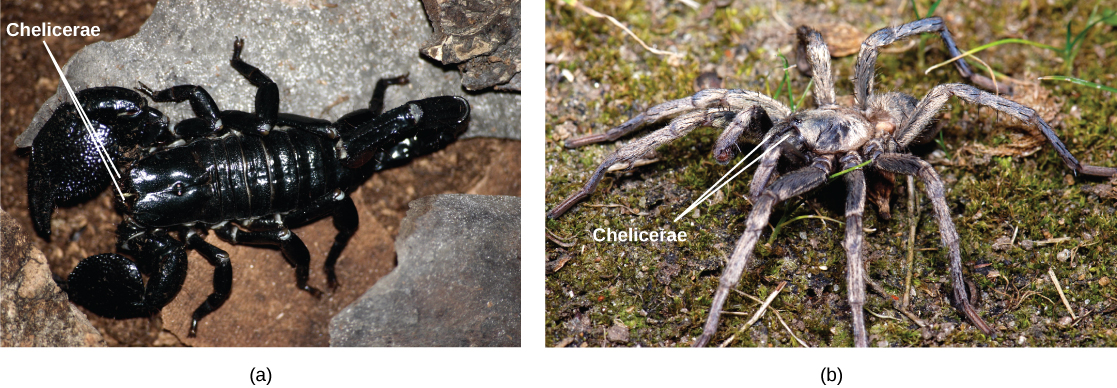| << Chapter < Page | Chapter >> Page > |

Subphylum Chelicerata includes animals such as spiders, scorpions, horseshoe crabs, and sea spiders. This subphylum is predominantly terrestrial, although some marine species also exist. An estimated 103,000 “Number of Living Species in Australia and the World,” A.D. Chapman, Australia Biodiversity Information Services, last modified August 26, 2010, http://www.environment.gov.au/biodiversity/abrs/publications/other/species-numbers/2009/03-exec-summary.html. described species are included in subphylum Chelicerata.
The body of chelicerates may be divided into two parts and a distinct “head” is not always discernible. The phylum derives its name from the first pair of appendages: the chelicerae ( [link] a ), which are specialized mouthparts. The chelicerae are mostly used for feeding, but in spiders, they are typically modified to inject venom into their prey ( [link] b ). As in other members of Arthropoda, chelicerates also utilize an open circulatory system, with a tube-like heart that pumps blood into the large hemocoel that bathes the internal organs. Aquatic chelicerates utilize gill respiration, whereas terrestrial species use either tracheae or book lungs for gaseous exchange.

Click through this lesson on arthropods to explore interactive habitat maps and more.
Flatworms are acoelomate, triploblastic animals. They lack circulatory and respiratory systems, and have a rudimentary excretory system. The digestive system is incomplete in most species. There are four traditional classes of flatworms, the largely free-living turbellarians, the ectoparasitic monogeneans, and the endoparasitic trematodes and cestodes. Trematodes have complex life cycles involving a secondary mollusk host and a primary host in which sexual reproduction takes place. Cestodes, or tapeworms, infect the digestive systems of primary vertebrate hosts.
Nematodes are pseudocoelomate members of the clade Ecdysozoa. They have a complete digestive system and a pseudocoelomic body cavity. This phylum includes free-living as well as parasitic organisms. They include dioecious and hermaphroditic species. Nematodes have a poorly developed excretory system. Embryonic development is external and proceeds through larval stages separated by molts.
Arthropods represent the most successful phylum of animals on Earth, in terms of number of species as well as the number of individuals. They are characterized by a segmented body and jointed appendages. In the basic body plan, a pair of appendages is present per body segment. Within the phylum, classification is based on mouthparts, number of appendages, and modifications of appendages. Arthropods bear a chitinous exoskeleton. Gills, tracheae, and book lungs facilitate respiration. Embryonic development may include multiple larval stages.

Notification Switch
Would you like to follow the 'Concepts of biology' conversation and receive update notifications?